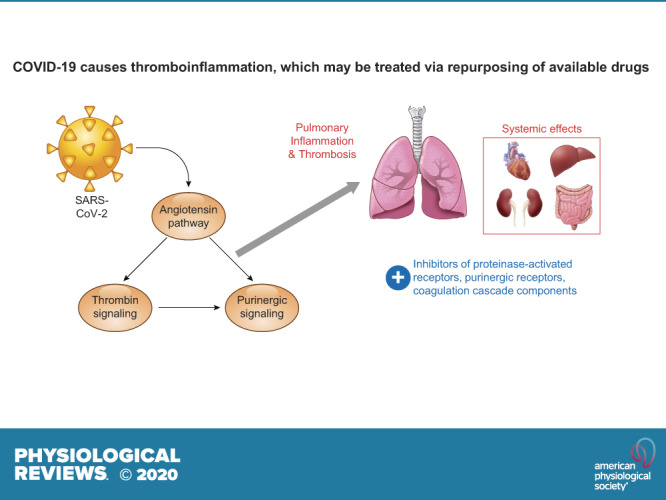- Record: found
- Abstract: found
- Article: not found
Inflammation and thrombosis in COVID-19 pathophysiology: proteinase-activated and purinergic receptors as drivers and candidate therapeutic targets

Read this article at
Abstract
Abstract
Evolving information has identified disease mechanisms and dysregulation of host biology that might be targeted therapeutically in coronavirus disease 2019 (COVID-19). Thrombosis and coagulopathy, associated with pulmonary injury and inflammation, are emerging clinical features of COVID-19. We present a framework for mechanisms of thrombosis in COVID-19 that initially derive from interaction of SARS-CoV-2 with ACE2, resulting in dysregulation of angiotensin signaling and subsequent inflammation and tissue injury. These responses result in increased signaling by thrombin (proteinase-activated) and purinergic receptors, which promote platelet activation and exert pathological effects on other cell types (e.g., endothelial cells, epithelial cells, and fibroblasts), further enhancing inflammation and injury. Inhibitors of thrombin and purinergic receptors may, thus, have therapeutic effects by blunting platelet-mediated thromboinflammation and dysfunction in other cell types. Such inhibitors include agents (e.g., anti-platelet drugs) approved for other indications, and that could be repurposed to treat, and potentially improve the outcome of, COVID-19 patients. COVID-19, caused by the SARS-CoV-2 virus, drives dysregulation of angiotensin signaling, which, in turn, increases thrombin-mediated and purinergic-mediated activation of platelets and increase in inflammation. This thromboinflammation impacts the lungs and can also have systemic effects. Inhibitors of receptors that drive platelet activation or inhibitors of the coagulation cascade provide opportunities to treat COVID-19 thromboinflammation.
Related collections
Most cited references197
- Record: found
- Abstract: found
- Article: not found
Clinical features of patients infected with 2019 novel coronavirus in Wuhan, China
- Record: found
- Abstract: found
- Article: found
Presenting Characteristics, Comorbidities, and Outcomes Among 5700 Patients Hospitalized With COVID-19 in the New York City Area
- Record: found
- Abstract: found
- Article: not found

